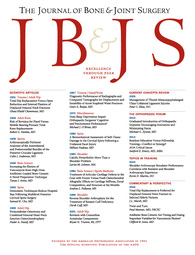
ARTHROPLASTY
36mm metal-on-metal THA increases metal ion & erythrocyte cobalt levels vs 28mm bearing
This report has been verified
by one or more authors of the
original publication.
J Bone Joint Surg Am. 2014 Mar 19;96(6):448-55. doi: 10.2106/JBJS.M.00164.
105 patients with unilateral noninflammatory degenerative joint disease were randomized to undergo total hip arthroplasty using either a 28mm metal-on-metal bearing surface, a 36mm metal-on-metal bearing surface, or a 28mm metal-on-polyethylene bearing surface. The purpose of this study was to compare metal ion levels and clinical outcomes between the three treatment groups. Upon analysis, the metal-on-polyethylene group demonstrated significantly lower metal ion levels in serum and whole blood compared to both of the metal-on-metal groups, while increasing metal ion levels over time and higher erythrocyte cobalt levels were observed in the 36mm metal-on-metal group. Mean HHS scores, WOMAC scores, and SF-12 mental and physical scores were similar between all three treatment groups.
Unlock the full ACE Report
You have access to {0} free articles per month.Click below to unlock and view this {1}
Unlock NowCritical appraisals of the latest, high-impact randomized controlled trials and systematic reviews in orthopaedics
Access to OrthoEvidence podcast content, including collaborations with the Journal of Bone and Joint Surgery, interviews with internationally recognized surgeons, and roundtable discussions on orthopaedic news and topics
Subscription to The Pulse, a twice-weekly evidence-based newsletter designed to help you make better clinical decisions
Exclusive access to original content articles, including in-house systematic reviews, and articles on health research methods and hot orthopaedic topics
Or upgrade today and gain access to all OrthoEvidence content for just $1.99 per week.
Already have an account? Log in


Subscribe to "The Pulse"
Evidence-Based Orthopaedics direct to your inbox.
{0} of {1} free articles
Become an OrthoEvidence Premium Member. Expand your perspective with high-quality evidence.
Upgrade Now













































































